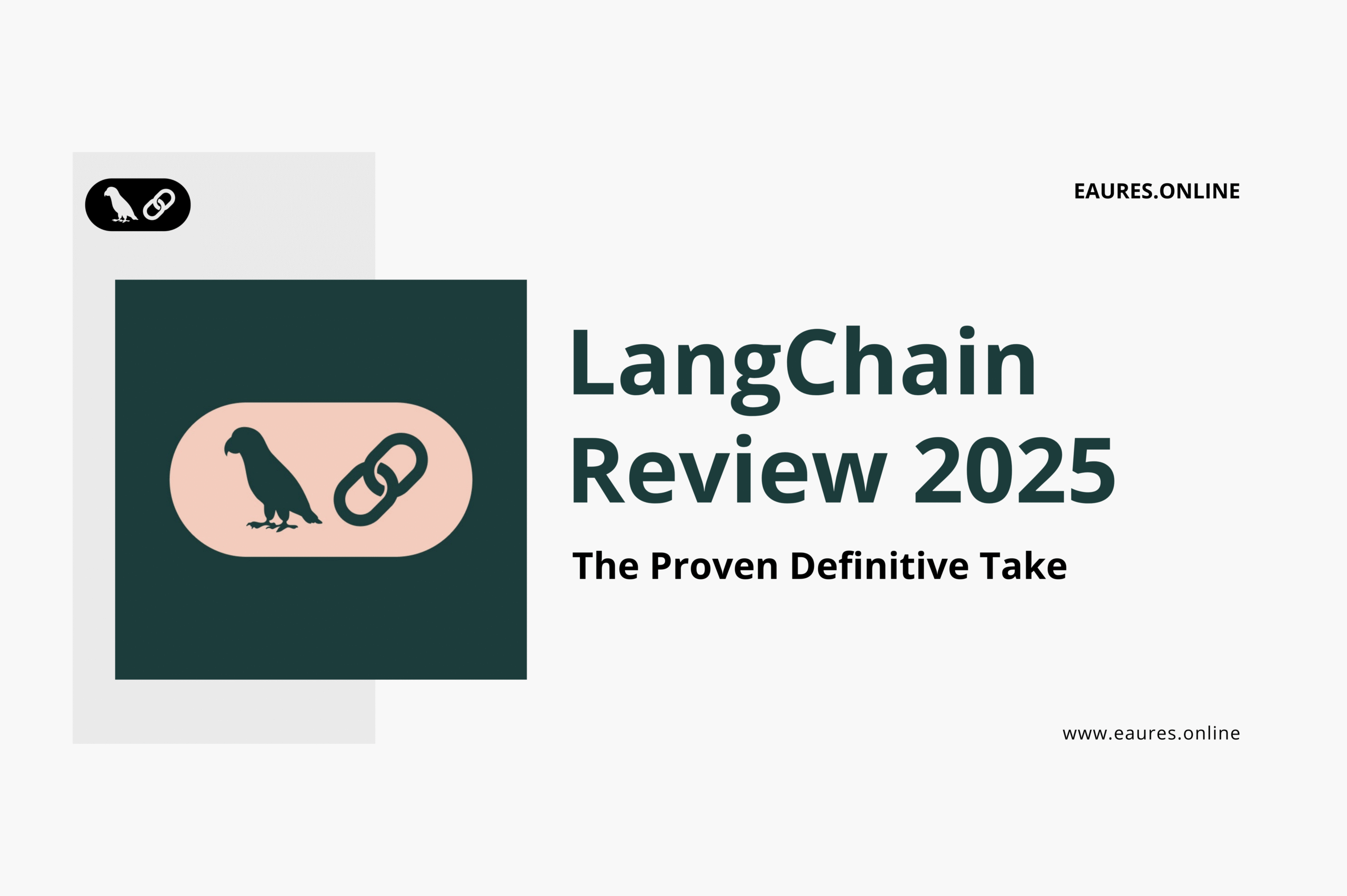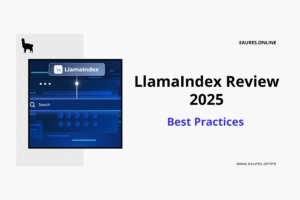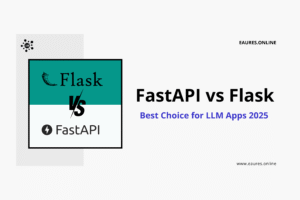Table of Contents
LangChain Review 2025: Definitive Take
Executive Summary — LangChain Review at a Glance
This LangChain Review distills what matters in 2025: a maturing framework that moved beyond “toy chains” into production‑ready building blocks for retrieval‑augmented generation (RAG), agentic workflows, and observability. The short version: if you plan to ship AI apps that go beyond a single prompt call—searching knowledge bases, orchestrating tools, calling structured APIs, or executing multistep workflows—LangChain remains one of the most complete and rapidly evolving stacks you can adopt. Its modern surface area centers on LCEL (stream‑first composition), LangGraph (stateful, tool‑using agents and workflows), LangServe (lightweight serving), and LangSmith (observability, evals, and dataset management). Together, these give teams a practical path from prototype to reliable production.
We’ll evaluate developer experience, architectural primitives, RAG quality, agents, deployment patterns, governance, and total cost of ownership. We’ll also show when LangChain is the right tool—and when you may want alternatives. Along the way, this LangChain Review provides actionable patterns, code snippets, and decision frameworks for 2025.
What Is LangChain? A Grounded LangChain Review of the Stack
LangChain is an open‑source framework that standardizes how you compose LLM applications: models, prompts, tools, retrievers, memory, and control flow. In 2025 it is best understood as a set of interoperable layers:
- LCEL (LangChain Expression Language): a typed, composable, streaming‑first API to build chains.
- LangGraph: a graph runtime that lets you build stateful, tool‑using, multi‑actor agents and workflows with explicit edges, guards, and retries.
- LangServe: a way to turn your chains and graphs into HTTP endpoints with tracing baked in.
- LangSmith: observability (traces, spans, datasets), evaluation, and feedback collection for continuous improvement.
If you’re deciding how to structure a production AI app, this LangChain Review will emphasize how those parts click together, and when the whole is more than the sum of its parts.
Why This LangChain Review Matters in 2025
From regulated industries to high‑traffic consumer apps, enterprise LLM adoption has forced frameworks to get serious about reliability, measurement, and lifecycle. Developers must move past ad‑hoc prompts toward repeatable pipelines: canonical retrieval, consistent tool execution, safe agent “guardrails,” and automated evals. This LangChain Review focuses on those production realities—what’s ergonomic, what’s stable, what’s observable, and what’s ready for audit.
What’s New and Notable in 2025
This year’s LangChain Review spotlights four areas that shifted how teams build:
- LCEL everywhere. Stream‑first composition means your app can yield partial tokens, intermediate tool calls, and structured output without bailing on type safety. LCEL’s declarative chaining reduces callback boilerplate and makes log/trace semantics uniform.
- LangGraph for stateful flows. Rather than “let the model decide everything,” you draw an explicit graph of states (plan, retrieve, reason, act, reflect). You get retries per edge, deterministic transitions, and interpretable traces—perfect for human‑in‑the‑loop review.
- LangServe for operational simplicity. Turning a chain/graph into a live endpoint is straightforward, with guardrails and LangSmith tracing on by default. This helps platform teams standardize deployments across services.
- Pragmatic connectors and tool use. The ecosystem of retrievers, vector stores, file loaders, and tool abstractions is broad. For RAG, expect first‑class connectors to Pinecone, Weaviate, Milvus, FAISS, and cloud‑native search backends—and well‑traveled patterns for chunking, hybrid search, and re‑ranking.

Who Should Choose LangChain vs Alternatives
In this LangChain Review, we find LangChain ideal if you:
- Need tool‑using agents (APIs, SQL, search, code execution) with auditable control flow.
- Plan to scale RAG beyond one index: multiple retrievers, hybrid reranking, and dataset monitoring.
- Want observability-first development with an integrated way to run evals and ship improvements.
- Prefer Python or TypeScript with a mature ecosystem of loaders and integrations.
If your use case is primarily RAG and you want a document‑centric mental model, you may prefer to compare LangChain vs LlamaIndex on architecture, DX, and performance; this practical guide on choosing between LangChain vs LlamaIndex for RAG, agents, and production apps can help you make that call within your team.
Architecture Overview — The Building Blocks That Matter
LCEL: Stream‑First Composition
LCEL lets you chain together models, prompts, retrievers, and parsers with streaming as a first‑class concern. Instead of threading callbacks through your code, you compose nodes that produce structured, partially streamed values. In practice, LCEL makes it easy to:
- Stage I/O (retrieval → LLM → tool → LLM) without spaghetti callbacks.
- Swap models (OpenAI, Anthropic, local) and retrievers (vector DBs, BM25, hybrid) via uniform interfaces.
- Emit structured output (pydantic/JSON) with robust error recovery.
LangGraph: Explicit Control and State
LangGraph models your app as a state machine with nodes (e.g., Plan, Retrieve, Reason, Act, Reflect) and typed edges. This boosts reliability and auditability: you can retry specific edges, measure elapsed time per step, and implement guard checks before tools execute. Many teams use LangGraph to replace fragile “agent loops” with deterministic workflows that can still be smart and adaptive.
Tools and Tooling
Tool use is now table stakes. LangChain’s Tool abstraction covers:
- API calls (REST/GraphQL), databases (SQL/NoSQL), files, search, code execution, and scheduling.
- Typed schemas so the model knows how to call tools and validators can reject malformed invocations.
- Concurrency controls so a misbehaving model can’t flood downstream systems.
Observability with LangSmith
LangSmith provides tracing, dataset management, prompt/version diffs, E2E evals, and feedback collection. Crucially, it aligns with LCEL/LangGraph semantics, so spans make sense. You can run regression suites across prompts and data to prove your app gets better, not just different.
Developer Experience (DX) — A Frank LangChain Review
Language and Frameworks
- Python remains the most complete SDK with deep notebooks and data tooling.
- TypeScript is increasingly first‑class for web stacks. If your app is UI‑heavy and serverless, TS + LangServe endpoints is a pleasant path.
Docs, Examples, and Templates
If you’re a builder, curated templates speed you up. To kickstart projects, explore these production‑grade starting points in the 7 best LangChain templates for LLMs in 2025—covering RAG, agents, multimodal, LangServe, and LangSmith. You’ll find patterns that reflect how teams actually ship apps this year.
Testing and CI
The best LangChain teams treat prompts and graphs as code:
- Commit prompts to version control with snapshots and fixtures.
- Write unit tests for tools and retrievers; run contract tests for structured outputs.
- Use LangSmith datasets and eval pipelines in CI to keep behavior stable.
RAG, Done Right — A Practical LangChain Review of Retrieval
Core RAG Pipeline
A robust RAG system with LangChain typically includes:
- Ingestion & chunking: clean text, normalize, split with semantic boundaries.
- Indexing: vector DB + metadata filters + embeddings; optional hybrid search with BM25.
- Retrieval: top‑k + re‑ranking (cross‑encoder) + diversity sampling.
- Synthesis: prompt templates with guards; citation formatting; structured output.
- Evaluation: answer faithfulness, context recall, groundedness; dataset drift alerts.
- Feedback loop: store traces, collect thumbs/comments, auto‑promote improvements.
Use vector stores like Pinecone, Weaviate, Milvus, or FAISS via standard LangChain retriever interfaces. For model providers, keep adapters handy for OpenAI and Anthropic so you can A/B models with minimal code changes.
Guardrails and Determinism
This LangChain Review recommends using structured output parsers and function/tool schemas so your LLM can fail fast and retry safely. Combine content filters, PII detectors, or regex validators in LCEL pipelines to keep outputs within policy.
RAG Evaluation
Evals should be built in from day one:
- Faithfulness: does the answer stick to retrieved context?
- Answer correctness: does it resolve the user task?
- Attribution: does it cite the right passages?
- Latency & cost: are you meeting SLOs?
You can orchestrate such evals inside LangSmith and track regressions over time. For open‑source tooling, the RAGAS project provides helpful metrics you can adapt.

Agents and Workflows — LangGraph in Practice
Why Graphs
Classic agent loops can hallucinate tools or spin indefinitely. LangGraph replaces that with an explicit state machine, where tool calls are validated and branches are predictable. This makes incident response feasible: you can replay traces, inspect spans, and pinpoint where a plan derailed.
Typical Pattern
- Plan the work (parse user goal → steps).
- Retrieve knowledge if needed.
- Act via tools with typed inputs.
- Reflect on results; either answer or iterate.
- Escalate to human when confidence is low.
This LangChain Review finds LangGraph particularly strong for analytics copilots, customer support automation, document workflows, and multi‑tool backoffice bots.
Serving, Ops, and MLOps — Shipping with Confidence
LangServe Endpoints
Turning chains/graphs into production endpoints is simpler with LangServe. You get request validation, tracing by default, easy streaming to clients, and a mental model that aligns with LCEL and LangGraph. Teams often mount multiple endpoints: /query, /classify, /report, each serving a specific chain with independent SLOs.
Observability with LangSmith
LangSmith helps you collect:
- Traces & spans: every prompt, tool, and retrieval call.
- Datasets: curated conversations, golden answers, and ground truth.
- Evals: pass/fail and numeric metrics across releases.
- Feedback: thumbs, comments, or labels from beta users.
With this loop in place, your LangChain Review won’t stop at “it works on my laptop”—you’ll have evidence it keeps working after deploy.

Cost, Latency, and TCO — A Pragmatic LangChain Review
Cost Control Levers
- Retriever hygiene: tune chunking, top‑k, and re‑rankers to reduce unnecessary tokens.
- Prompt budgets: enforce token ceilings; stream partials to the UI.
- Caching: cache context transforms, embeddings, and deterministic tool calls.
- Model right‑sizing: run cheaper models for easy tasks and reserve premium models for complex steps.
Latency Strategies
- Parallelize independent steps in LCEL/LangGraph.
- Pre‑compute slow retrievals for popular queries.
- Streaming UIs so users see progress instantly.
The upshot of this LangChain Review: LangChain doesn’t magically lower your bill, but it gives the control points (retrieval efficiency, tool contracts, streaming) to achieve predictable cost and latency.
Security, Privacy, and Governance
Production AI demands guardrails and auditability:
- Input sanitation: strip secrets, normalize encodings, reject disallowed content early.
- Output validation: enforce schemas, check for PII leakage, and apply policy filters before returning responses.
- Data residency: ensure embeddings and logs conform to regional constraints.
- Audit trails: keep LangSmith traces to reconstruct decisions and answer compliance reviews.
A recurring theme in this LangChain Review: governance is easier when state and edges are explicit—another reason graphs beat opaque agent loops.
Quickstart: A Minimal Yet Production‑Minded RAG with LCEL
Below is a conceptual sketch (Python‑flavored) to illustrate composition and production‑ready concerns:
from langchain_openai import ChatOpenAI, OpenAIEmbeddings
from langchain.text_splitter import RecursiveCharacterTextSplitter
from langchain_community.vectorstores import Pinecone
from langchain_core.prompts import ChatPromptTemplate
from langchain_core.output_parsers import JsonOutputParser
from langchain_core.pydantic_v1 import BaseModel, Field
from langchain_core.runnables import RunnableParallel, RunnablePassthrough
# 1) Ingestion
splitter = RecursiveCharacterTextSplitter(chunk_size=800, chunk_overlap=120)
chunks = splitter.split_text(load_corpus()) # your loader here
# 2) Index (use your preferred vector DB)
emb = OpenAIEmbeddings(model="text-embedding-3-small")
index = Pinecone.from_texts(chunks, embedding=emb, index_name="docs-2025")
# 3) Retrieval
retriever = index.as_retriever(search_type="hybrid", search_kwargs={"k": 6})
# 4) Prompt + structured output
class Answer(BaseModel):
answer: str = Field(..., description="Concise answer for the user.")
sources: list[str] = Field(..., description="Cited passage ids or urls.")
prompt = ChatPromptTemplate.from_messages([
("system", "Answer using only the provided context. Cite sources."),
("human", "Question: {question}\n\nContext:\n{context}")
])
parser = JsonOutputParser(pydantic_object=Answer)
model = ChatOpenAI(model="gpt-4o-mini", temperature=0)
# 5) LCEL chain with streaming capability
rag_chain = (
{"context": retriever, "question": RunnablePassthrough()}
| prompt
| model
| parser
)
# Usage: rag_chain.stream("How does feature X work?")
This sketch shows LCEL’s mapping + piping style: assemble inputs, prompt, model, and parser into a single streamable unit. In production, wrap this in LangServe, trace it in LangSmith, and add evals to prevent regressions.
Building Agentic Workflows with LangGraph (Sketch)
from langgraph.graph import StateGraph, END
from typing import TypedDict
class State(TypedDict):
question: str
plan: list[str]
context: str
answer: str
retries: int
def plan(state: State) -> State:
# create step list based on question
state["plan"] = ["retrieve", "reason", "act", "answer"]
return state
def retrieve(state: State) -> State:
state["context"] = retrieve_docs(state["question"])
return state
def reason(state: State) -> State:
# call LLM with context to build draft
state["answer"] = llm_reason(state["question"], state["context"])
return state
def act(state: State) -> State:
# optional: call tools (sql/api) if plan requires
return state
def finalize(state: State) -> State:
return state
graph = StateGraph(State)
graph.add_node("plan", plan)
graph.add_node("retrieve", retrieve)
graph.add_node("reason", reason)
graph.add_node("act", act)
graph.add_node("finalize", finalize)
graph.add_edge("plan", "retrieve")
graph.add_edge("retrieve", "reason")
graph.add_edge("reason", "act")
graph.add_edge("act", "finalize")
graph.set_entry_point("plan")
graph.add_edge("finalize", END)
app = graph.compile()
# app.invoke({"question":"Generate a quarterly report from our knowledge base"})
Why include this in a LangChain Review? Because the clarity and debuggability of explicit graphs is what separates “cool demo” from “measurable, controllable system” in 2025.
Real‑World Scenarios — Applying This LangChain Review
1) Data Analyst Copilot
A practical win is an analyst copilot that profiles CSVs, validates schema, retrieves business context, and generates structured insights. For a full walkthrough that complements this LangChain Review, see how to automate data analysis with Python + LLMs—validating CSVs, profiling data, adding RAG context, and generating structured insights end‑to‑end.
2) Customer Support Search + Summarize
Use LCEL to fuse semantic retrieval, FAQ fallbacks, and policy‑aware prompts. Add LangSmith evals that measure correctness and safe response rates. LangGraph can route low‑confidence cases to human agents.
3) Engineering Assistants
If your org is exploring coding copilots, align LangChain workflows with your IDE and CI. For landscape awareness and pricing/benchmarks, consult this hands‑on guide to the best AI code assistants in 2025 to decide where LangChain‑based tools fit among IDE‑native options.
Benchmarks and Quality — How to Evaluate in 2025
A responsible LangChain Review must talk about evidence. Instead of chasing a single headline number, build a multidimensional eval suite:
- Task accuracy: scenario‑specific correctness (e.g., finance Q&A, internal policy lookup).
- Groundedness: penalize answers that cite nothing or cite irrelevant passages.
- Tool compliance: ensure the agent calls tools with valid inputs and handles errors.
- Regression safety: run a diff of traces (+ latency, + cost) before each release.
If your use case touches code or bug fixing, see if improvements translate to higher merge rates in practice and cross‑reference public datasets such as SWE‑bench for methodology and task style. For RAG workloads, align metrics with business outcomes (deflection rate, time‑to‑answer, CSAT), not just BLEU‑style scores.

Pros and Cons — A Balanced LangChain Review
Strengths
- Complete stack: LCEL + LangGraph + LangServe + LangSmith cover build → ship → measure.
- Ecosystem depth: loaders, retrievers, and tools for most enterprise systems.
- Observability: first‑class tracing and evals; crucial for audits and continuous improvement.
- DX: composable patterns and templates; easy to swap models/providers.
Trade‑offs
- Abstraction layers: new users may face a learning curve understanding LCEL vs LangGraph boundaries.
- Over‑engineering risk: small apps can be overspecified if you jump to graphs prematurely.
- API churn: fast‑moving ecosystem means you should pin versions and watch release notes.
Fit Summary
If your application is a single‑prompt toy, you don’t need LangChain. If it’s a stateful system with retrieval, tools, and SLOs, the ecosystem and observability frequently justify the complexity.
Alternatives and Complementary Tools
This LangChain Review isn’t complete without alternatives:
- LlamaIndex (document‑centric RAG with strong indexing abstractions). For a deeper decision framework, refer to the practical comparison of LangChain vs LlamaIndex for RAG, agents, and production apps.
- Direct SDKs (OpenAI/Anthropic) if your app is minimal and you want fewer moving parts.
- Custom orchestration with message brokers and typed services if you already have a platform team maintaining an internal “agent runtime.”
Best Practices Checklist — From This LangChain Review to Your Backlog
- Start with RAG correctness before agent complexity.
- Use LCEL for streaming, schema validation, and structured outputs.
- Adopt LangGraph only where statefulness improves reliability and auditability.
- Instrument with LangSmith on day one—treat traces/datasets as first‑class.
- Pin versions and guard your prompts with unit tests and evals.
- Budget tokens (input/output caps) and cache deterministic transforms.
- Design for fallback paths (FAQ, keyword search, human handoff).
- Make security policy explicit in code, not just runbooks.
Final Verdict — The 2025 LangChain Review in One Sentence
If you need to build reliable, observable, and stateful AI systems in 2025, LangChain’s LCEL + LangGraph + LangServe + LangSmith combination remains one of the most cohesive and production‑ready paths from idea to impact.
FAQs — Fast Answers from This LangChain Review
Is LangChain overkill for simple chatbots?
Often yes. If you don’t need retrieval, tools, or observability, a direct model SDK may be enough. This LangChain Review recommends starting simple and adding structure only as complexity grows.
Does LangChain lock me in?
No. Models, vector stores, and tools are modular. You can migrate providers by swapping adapters and prompts.
Is Python still the best way to use LangChain?
For data‑heavy backends and notebooks, yes. For web/product teams, TypeScript is increasingly comfortable—especially with serverless endpoints.
How do I measure quality?
Use LangSmith datasets/evals plus business metrics like deflection, CSAT, or merge rates. Keep a golden set and run regression checks before deploys.
When should I choose LangGraph?
When you need explicit state (e.g., multi‑step plans, escalations, or tool sequences) that must be auditable, retryable, and testable.
Where to Go Next
To accelerate your build, scan these curated resources that pair naturally with this LangChain Review:
- Dive into LangChain documentation for LCEL concepts and cookbook patterns.
- Explore LangGraph docs for stateful agents and workflows.
- Turn prototypes into services with LangServe and trace everything in LangSmith.
- For vector stores, compare Pinecone, Weaviate, Milvus, and FAISS.
- If you’re choosing coding copilots, see the landscape in this 2025 code assistant guide.
- To start strong with scaffolding, grab the 7 best LangChain templates for LLMs in 2025.
Suggested Internal Reading to Complement This LangChain Review
- For hands‑on RAG vs agent trade‑offs, study the LangChain vs LlamaIndex decision guide.
- For analytics copilots, follow an end‑to‑end recipe in Automate Data Analysis with Python + LLMs.





[url=byfurniture.ry]Дизайнерская мебель премиум класса[/url] — это воплощение изысканного стиля и безукоризненного качества.
Элитная мебель от дизайнеров — это не просто предметы интерьера, а настоящие произведения искусства. Уникальный подход к созданию каждой вещи делает ее выдающимся элементом интерьера. Премиум мебель становится все более популярной среди ценителей качества.